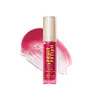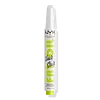What's inside
What's inside
 Key Ingredients
Key Ingredients

 Benefits
Benefits

 Concerns
Concerns

 Ingredients Side-by-side
Ingredients Side-by-side

Hydrogenated Polyisobutene
EmollientHelianthus Annuus Hybrid Oil
EmollientPolybutene
Ethylene/Propylene/Styrene Copolymer
Corylus Avellana Seed Oil
EmollientCaprylic/Capric Triglyceride
MaskingButylene/Ethylene/Styrene Copolymer
Bis-Diglyceryl Polyacyladipate-2
EmollientSodium Saccharin
MaskingDiethylhexyl Syringylidenemalonate
Skin ProtectingGlycine Soja Oil
EmollientTocopheryl Acetate
AntioxidantJasminum Officinale Flower Extract
MaskingPaeonia Officinalis Flower Extract
TonicPrunus Serrulata Flower Extract
Skin ConditioningCitrus Aurantium Amara Flower Extract
RefreshingLavandula Angustifolia Flower Extract
CleansingRosa Damascena Flower Oil
MaskingTocopherol
AntioxidantHelianthus Annuus Seed Oil
EmollientSambucus Nigra Flower Extract
RefreshingCitrus Aurantifolia Oil
CleansingSimmondsia Chinensis Seed Oil
EmollientCymbopogon Citratus Leaf Oil
MaskingPrunus Cerasus Fruit Extract
AntioxidantMangifera Indica Fruit Extract
Skin ConditioningLitchi Chinensis Pericarp Extract
Skin ConditioningAverrhoa Carambola Fruit Extract
Skin ConditioningPunica Granatum Bark Extract
MaskingLycium Chinense Leaf Extract
Skin ConditioningBrassica Alba Seed Extract
Skin ConditioningCucurbita Pepo Seed Extract
Skin ConditioningCamellia Sinensis Leaf Extract
AntimicrobialVanilla Planifolia Seed Powder
AbrasiveRubus Villosus Leaf Extract
Skin ConditioningZingiber Officinale Root Extract
MaskingGlycerin
HumectantWater
Skin ConditioningAroma
Pentaerythrityl Tetra-Di-T-Butyl Hydroxyhydrocinnamate
AntioxidantPentaerythrityl Tetraisostearate
EmollientEthylhexylglycerin
Skin ConditioningPhenoxyethanol
PreservativeAluminum Hydroxide
EmollientCI 77120
Cosmetic ColorantRosin
CI 15850
Cosmetic ColorantCI 42090
Cosmetic ColorantCI 19140
Cosmetic ColorantHydrogenated Polyisobutene, Helianthus Annuus Hybrid Oil, Polybutene, Ethylene/Propylene/Styrene Copolymer, Corylus Avellana Seed Oil, Caprylic/Capric Triglyceride, Butylene/Ethylene/Styrene Copolymer, Bis-Diglyceryl Polyacyladipate-2, Sodium Saccharin, Diethylhexyl Syringylidenemalonate, Glycine Soja Oil, Tocopheryl Acetate, Jasminum Officinale Flower Extract, Paeonia Officinalis Flower Extract, Prunus Serrulata Flower Extract, Citrus Aurantium Amara Flower Extract, Lavandula Angustifolia Flower Extract, Rosa Damascena Flower Oil, Tocopherol, Helianthus Annuus Seed Oil, Sambucus Nigra Flower Extract, Citrus Aurantifolia Oil, Simmondsia Chinensis Seed Oil, Cymbopogon Citratus Leaf Oil, Prunus Cerasus Fruit Extract, Mangifera Indica Fruit Extract, Litchi Chinensis Pericarp Extract, Averrhoa Carambola Fruit Extract, Punica Granatum Bark Extract, Lycium Chinense Leaf Extract, Brassica Alba Seed Extract, Cucurbita Pepo Seed Extract, Camellia Sinensis Leaf Extract, Vanilla Planifolia Seed Powder, Rubus Villosus Leaf Extract, Zingiber Officinale Root Extract, Glycerin, Water, Aroma, Pentaerythrityl Tetra-Di-T-Butyl Hydroxyhydrocinnamate, Pentaerythrityl Tetraisostearate, Ethylhexylglycerin, Phenoxyethanol, Aluminum Hydroxide, CI 77120, Rosin, CI 15850, CI 42090, CI 19140
Bis-Diglyceryl Polyacyladipate-2
EmollientPolyisobutene
Tridecyl Trimellitate
EmollientDiisostearyl Malate
EmollientPentaerythrityl Tetraisostearate
EmollientSynthetic Wax
AbrasivePolyglyceryl-2 Triisostearate
EmulsifyingPersea Gratissima Oil
Skin ConditioningRubus Chamaemorus Seed Oil
Skin ConditioningRubus Idaeus Seed Oil
EmollientTin Oxide
AbrasiveAroma
Synthetic Fluorphlogopite
Tocopheryl Acetate
AntioxidantPhenoxyethanol
PreservativeCI 15850
Cosmetic ColorantCI 77491
Cosmetic ColorantCI 77492
Cosmetic ColorantCI 77499
Cosmetic ColorantCI 77891
Cosmetic ColorantCI 19140
Cosmetic ColorantBenzyl Alcohol
PerfumingBis-Diglyceryl Polyacyladipate-2, Polyisobutene, Tridecyl Trimellitate, Diisostearyl Malate, Pentaerythrityl Tetraisostearate, Synthetic Wax, Polyglyceryl-2 Triisostearate, Persea Gratissima Oil, Rubus Chamaemorus Seed Oil, Rubus Idaeus Seed Oil, Tin Oxide, Aroma, Synthetic Fluorphlogopite, Tocopheryl Acetate, Phenoxyethanol, CI 15850, CI 77491, CI 77492, CI 77499, CI 77891, CI 19140, Benzyl Alcohol
Ingredients Explained
These ingredients are found in both products.
Ingredients higher up in an ingredient list are typically present in a larger amount.
Aroma refers to an ingredient, or mixture of ingredients, that impart or mask a flavor.
The name is slightly confusing. This is because INCI associates aroma with flavor instead of smell.
Here is the official definition from the The International Cosmetic Ingredient Dictionary and Handbook:
“Aroma is a term for ingredient labeling used to identify that a product contains a material or combination of materials normally added to a cosmetic to produce or to mask a particular flavor.”
INCI shows the only purpose of aroma to be "flavouring".
However, due to regulation differences, some companies may use aroma in place of parfum.
In Canada, this ingredient only has to be listed in concentrations above 1%.
Learn more about AromaThis ingredient is lipid-based synthetic skin-conditioning agent derived from adipic acid and a mixture of fatty acids. It is often called a lanolin substitute.
As an emollient, it helps soften and hydrate the skin. Emollients create a barrier on the skin to trap moisture in.
Due to its fatty acid base, it may not be Malassezia folliculitis safe.
Learn more about Bis-Diglyceryl Polyacyladipate-2Ci 15850 is the pigment color red. It is an azo dye and created synthetically.
Azo dyes need to be thoroughly purified before use. This allows them to be more stable and longer-lasting.
This ingredient is common in foundations, lipsticks, and blushes. This color is described as brown/orangey red.
It has many secondary names such as Red 6 and Red 7. According to a manufacturer, Red 6 usually contains aluminum.
Learn more about CI 15850CI 19140 is also known as Tartrazine. Tartrazine is a synthetic dye used in cosmetics, foods, and medicine to add a yellow color.
Tartrazine is created from petroleum and is water-soluble.
Some people may experience allergies from this dye, especially asthmatics and those with an aspirin intolerance.
Learn more about CI 19140Pentaerythrityl Tetraisostearate is derived from isostearic acid. It is an emollient and emulsifier.
The highest concentration of this ingredient is found in lipsticks.
This ingredient is minimally water soluble and may not be Malassezia folliculitis, or fungal-acne safe.
Learn more about Pentaerythrityl TetraisostearatePhenoxyethanol is a preservative that has germicide, antimicrobial, and aromatic properties. Studies show that phenoxyethanol can prevent microbial growth. By itself, it has a scent that is similar to that of a rose.
It's often used in formulations along with Caprylyl Glycol to preserve the shelf life of products.
Tocopheryl Acetate is AKA Vitamin E. It is an antioxidant and protects your skin from free radicals. Free radicals damage the skin by breaking down collagen.
One study found using Tocopheryl Acetate with Vitamin C decreased the number of sunburned cells.
Tocopheryl Acetate is commonly found in both skincare and dietary supplements.
Learn more about Tocopheryl Acetate